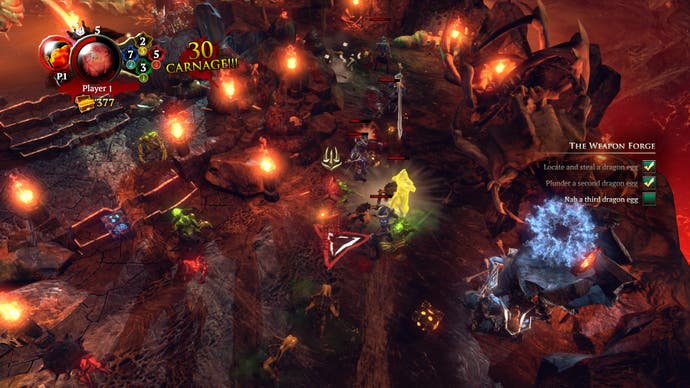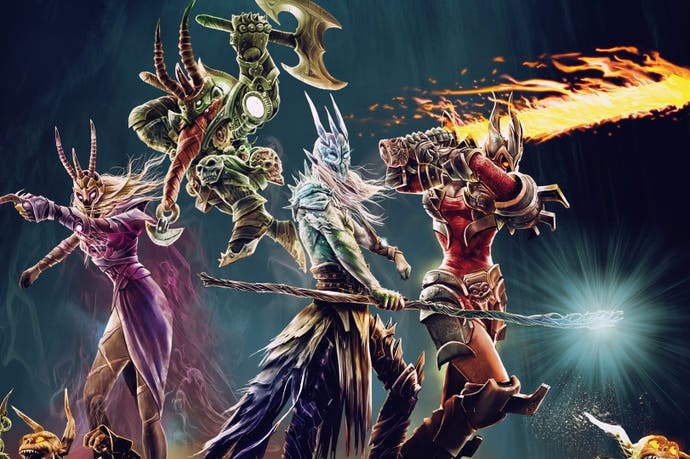Overlord: Fellowship of Evil review
Fillet minions.
Though far from perfect, the original Overlord and its 2009 sequel had one very important thing going for them: they were different.
Casting you as a newly resurrected evil deity - a thinly veiled off-brand Sauron from Lord of the Rings - you were able to gather a small army of skittering, gibbering minions and steer them around the screen en masse, causing mayhem and destruction, and generally putting the boot into a twee fantasy land that had it coming. Part strategy game, part puzzler, yet viewed as a third person action game, it's fair to say that there was nothing quite like them at the time, and there's still nothing like them now.
That's a problem, since in 2015 there's a new Overlord game, but it's one that has taken a sharp turn towards the generic, ditching the viewpoint, controls and genre-hopping of its predecessors and swapping them for a clumsy and drab top-down action RPG template.
Here's the new pitch: you are one of four Netherghuls, cursed warriors summoned from Hell by Gnarl, leader of the Overlord's minions. Your task - with up to three other players - is to bring evil back to the land after ten years of disgusting peace, love and happiness.
The four player characters set expectations appropriately low in terms of creativity and wit. Two are melee fighters, two specialise in ranged attacks. Inferna wields a flaming sword and has fire-based powers. Cryos, imaginatively, uses ice magic but prefers to cast spells from a distance. Similarly, dwarven tank Hawken gets in close with his axe, while necromancer Malady shoots bolts of purple death from afar.

Each offers a limited and linear skill tree progression, which increases damage and health, but throughout the game your arsenal never expands beyond a predictable trio of attack options: Fast Attack, Heavy Attack and Special Attack. Stop me if you've heard this before. Even if you cash in your loot for a new weapon, the change can be hard to spot. Equip Malady with a wand that has a chance to poison, electrocute or burn and it still shoots the same purple plasma.
Gameplay takes the form of tedious missions that lead you through linear environments in a Diablo-lite style. There's rarely an objective more complex than to simply follow the path to the next area, and nor are the maps troubled by many unusual or interactive features. Puzzles are sporadic and tissue thin - stand on this trigger, stand on that trigger. Occasionally you'll have to remember a sequence of four icons, or send a minion of a specific colour type through a barrier to stand on a trigger.
Yes, the minions are back but their use has been heavily altered. You no longer control them directly, but instead summon them from a single digit supply that is topped up by attacking portal towers, which spit out "minion cubes". Minions will follow you around and behave, broadly, according to their type. Browns are basic attack creatures, blues will hang back in combat but heal you if you stand still. Greens teleport and perform sneak attacks. Reds explode.
There's no subtlety or strategy to the way they're used though. You could choose to engage in combat personally in the originals, but it was often just that: a choice. That's no longer the case. You are now the primary deliverer of damage to enemies, with minions as a sort of bonus power-up that can distract and delay your foes. Even then, combat feels insubstantial and weightless, with attacks that whiff through enemies and ragdoll animations that lack gravity.
The result is a fumble, as you flick between shoulder and face button combinations to summon minions, while also trying to engage in floaty combat yourself using the same buttons. It never feels natural, your attention is divided in a clumsy way, and combat becomes a bland porride of the same spammed attacks and hurling every new minion into battle.

All of this would be discouraging enough, but a constant procession of bugs, glitches and obviously cut corners that put the lacklustre design into perspective.
The minion pathfinding AI, for instance, is completely broken. In many areas, and for no apparent reason, summoned minions will all simply rush to the same spot and start swiping at thin air. Often, they'll vanish completely, perish off-screen when no enemies are around or else run straight into a hazard and die. Checkpoints will slam closed metal gates, separating you from some or all of your minions.
Given that the minions become a fairly scarce and vital support resource in later stages, as enemies become tiresome damage sponges, every time the game's clanking code deprives you of one for no good reason feels like a slap in the face.
And still the bugs continue. The in-game cutscenes reveal some of the worst animation I've seen since the mid-90s. Thick box-like arms flail like a spasmodic Kermit, clipping through bodies. Legs flicker and pinwheel, making no contact with the ground.
Larger enemies with lengthy health bars will take literally no damage for minutes at a time, before suddenly and inexplicably falling down dead, still with full health, as if the game code dozed off, woke with a start and tried to catch up. On more than one occasion, scenes and levels simply didn't load in at all, leaving me with a black screen and the sound of my death as the game continued without visuals.

Even features that do work as intended reveal a curious approach to design. Weapons and minion hats can be purchased in your hub area, but equipping them means pointlessly trudging across the map from the vendor to another character, rather than simply having an inventory screen accessible from the menu. There's no in-game map either, and while the path you follow is entirely linear the confusing layouts are still full of dead ends and seemingly identical areas that can leave you wondering where you've been and where to go next.
The one aspect of this sorry mess that deserves unqualified praise is the script from Rhianna Pratchett, who gave the original games their playfully malevolent tone. Her silly, sarcastic dialogue, delivered with sneering aplomb by returning voice actor Marc Silk, is the only thing that truly connects Fellowship of Evil to the previous games, and gives it anything vaguely like a pulse.
Other than that, I can't think of a single thing that this game does well, or even adequately. Make no mistake, Fellowship of Evil doesn't disappoint just because it deviates from the series' past. Even in its best moments, the game is still a shallow, stodgy and repetitive slog that exists entirely in the shadow of games like Diablo and Torchlight. At worst, it's full of bewildering design choices and outright broken bits that feel desperately unpolished and frequently unfinished. Fans hoping for a revival of a cult favourite will be crushed, of course, but sadly newcomers are unlikely to find anything to enjoy either.










